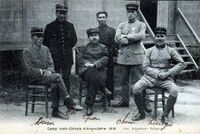User:Krugmar/Sandbox5
| Siamat War សង្គ្រាមសៀម (Svai) | |||||||
|---|---|---|---|---|---|---|---|
| |||||||
| Belligerents | |||||||
|
Supported by:
|
Supported by:
| ||||||
The Siamat War (Svai: សង្គ្រាមសៀម Sangkream Saimaut), known in Siamat as the Republican Liberation Conflict (Svai: ជម្លោះការរំដោះសាធារណរដ្ Chomloh kar Romdaoh Satharonarod), was a conflict in Siamat from the 8 May 1952 to 21 June 1978. It is considered to have official begun after the formation of the Provisional Republican Government (RSNA) on the 8 May 1952, though conflict between the monarchist government and republican forces had been endemic for a decade. It ended with the capture of Mouráng on the 21 June 1977, though some monarchist forces would hold out for a further decade. The Monarchists were largely supported by the EC and Senria, as well as various ICD nations, while the Republicans were supported by Shangea, Soravia, Kirenia, and Dezevau along with AESE allies.
Background
The Kingdom of Siamat came under Gaullican influence in the 19th century, culminating in an official protectorate in 1878. The 1885 Treaty of Wiesstadt saw some areas of Kuthina annexed to Siamat, and Gaullica's interests in the areas recognised by Werania and Estmere. Until 1911 Gaullica largely followed the policy of Règle princière, largely giving power and control to native officials and maintaining the traditional form of government. The 1908 Kansaeng Lueng revolt convinced Gaullican officials of the need to exert more control over Siamat. From 1911 to 1934 native institutions were largely dismantled, and a small civil service comprised entirely of ethnic Gaullicans transformed an indigineous protectorate into an economic colony.
Gaullica's surrender in 1934 in the Great War saw a brief period of independence, from 8 December 1934 to 4 March 1935, known as the Winter Period. Weranian troops established control over the newly created Community of Nations mandate. Werania largely kept the Gaullican system intact, utilising the small Gaullican community to run the colony. As a result of this and a lack of interest by Werania, Siamat had little Weranian influence on its politics or culture, but also became increasingly stunted in economic development. Werania did however implement free trade policies, replacing the previous Gaullican imperial preference system, which created a great interest for Euclean businesses, particularly Weranian and Estmerish, in Siamat's economy.
During the Weranian period emerged two figures with differing views for Siamat's future, though both came from the same strand of independentist and nationalist thought fermented by the failure of the Kansaeng Lueng revolt. Keo Samnang was a supporter of a constitutional monarchy, and argued that the path to independence would have to be one of patience and compromise with Weranian authorities. He would later serve a short term as an independent Siamat's second prime minister.
The republican movement largely coalesced under the leadership of Mao Bourey. Bourey had lost two brothers in the 1911 revolt and wrote extensively against Gaullican rule, and after 1915 lived in exile in Xiaodong. He fled to Senria in 1922 after Xiaodong joined the Entente, and returned to Siamat during the Winter Period to lead a short-lived revolt, which was later crushed by the Weranians. He later returned to Xiaodong and joined the Xiaodong Regeneration Society. While he became increasingly drawn to the tenets of National Principlism, he ensured that the Saim Muoy remained a broad church republican organisation.
Siamat remained under Weranian rule until the 21 January 1945, when the Mandate expired and Werania did not seek renewal. Weranian economic interests in Siamat largely remained unaffected, and the government of Siamat remained largely reliant upon links with Weranian business magnates and politicians for stability. Werania intervened several times to remove 'troublemakers' such as Keo Samnang from positions of power, which only strengthened growing nationalist and anti-monarchist movements. By 1952 the two largest organisations, the republican Saim Muoy, and the communist Sba Svay, had come to an agreement to form a provisional government and oust the monarchy, thus starting the Siamat War.
Insurgency period
Escalation
Growing outside involvement
Northern exit
Gaullican and Senrian exit
Endgame
Involvement of other countries
Pro-Mouráng
Pro-RSNA
Neutral and non-belligerent nations
War crimes
Kingdom of Siamat
RSNA
Allied forces



